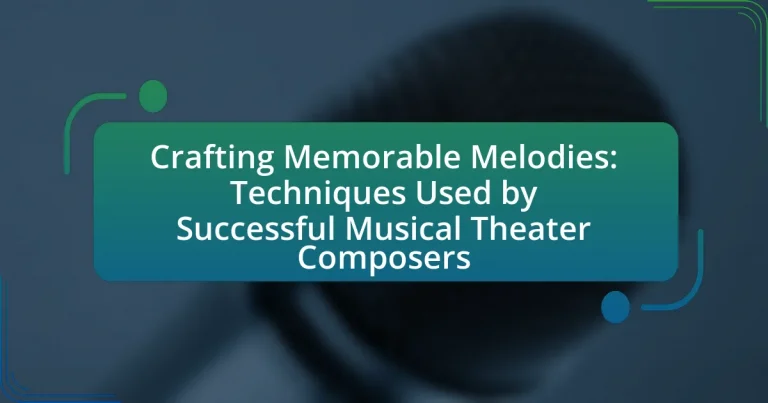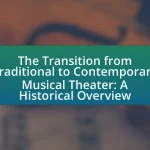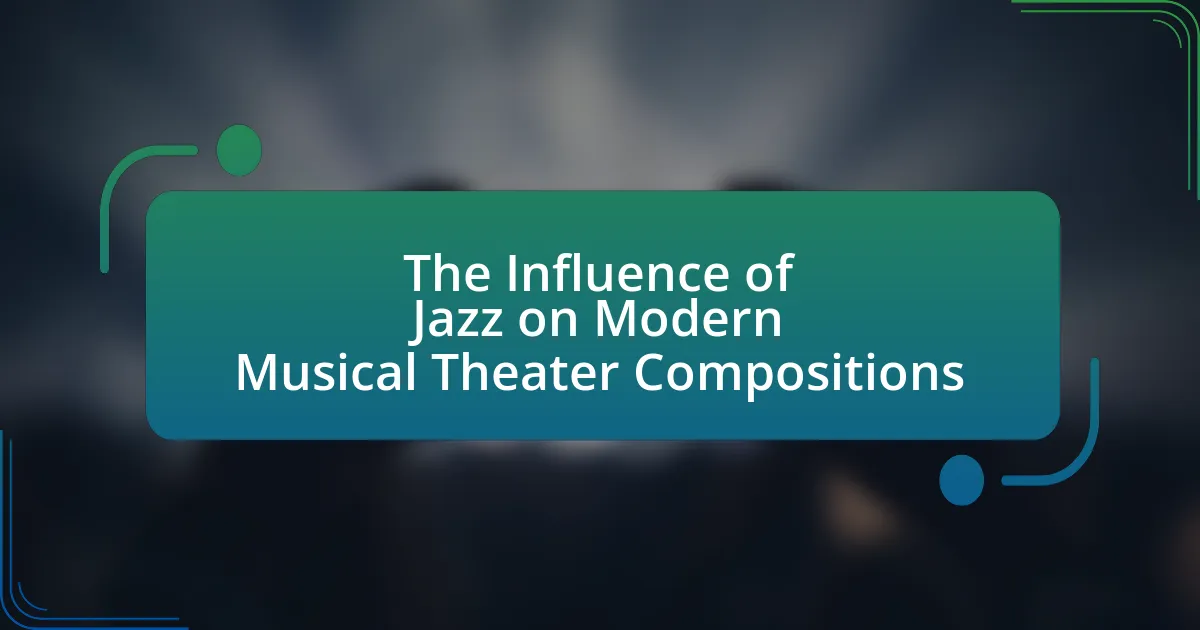The article focuses on the key techniques used by successful musical theater composers to craft memorable melodies. It outlines essential elements such as thematic material, emotional resonance, and the effective use of repetition, which contribute to the creation of impactful musical moments. The article also explores how composers like Stephen Sondheim and Lin-Manuel Miranda approach melody creation, emphasizing the importance of character development, rhythm, phrasing, and cultural influences. Additionally, it discusses common challenges faced by composers and offers practical tips for aspiring musicians to enhance their melody writing skills.

What are the key elements of crafting memorable melodies in musical theater?
The key elements of crafting memorable melodies in musical theater include strong thematic material, emotional resonance, and effective use of repetition. Strong thematic material provides a clear and identifiable musical idea that audiences can latch onto, while emotional resonance ensures that the melody aligns with the character’s feelings and the narrative context, enhancing the overall impact. Effective use of repetition reinforces the melody, making it more memorable and allowing audiences to recall it easily. These elements are supported by the practices of renowned composers like Stephen Sondheim and Lin-Manuel Miranda, who utilize these techniques to create iconic and lasting musical moments in their works.
How do successful composers approach melody creation?
Successful composers approach melody creation by employing a combination of thematic development, emotional resonance, and structural coherence. They often start with a central motif or idea, which serves as the foundation for the melody, allowing for variations and expansions that maintain listener interest. For instance, Stephen Sondheim frequently utilizes intricate melodic lines that reflect character emotions and narrative arcs, demonstrating how melody can enhance storytelling in musical theater. This method not only creates memorable tunes but also ensures that the melodies are deeply connected to the overall context of the performance, reinforcing the emotional impact on the audience.
What techniques do composers use to evoke emotion through melody?
Composers evoke emotion through melody by utilizing techniques such as melodic contour, harmony, rhythm, and dynamics. Melodic contour refers to the shape and direction of a melody, which can convey feelings of tension or resolution; for example, ascending melodies often evoke feelings of hope or joy, while descending melodies can suggest sadness or loss. Harmony plays a crucial role, as certain chord progressions, like the use of minor chords, can create a sense of melancholy, while major chords typically evoke happiness. Rhythm also influences emotional response; syncopation can create excitement or urgency, while a slow, steady rhythm can evoke calmness or introspection. Additionally, dynamics, or variations in volume, can heighten emotional impact; crescendos can build tension, while sudden drops in volume can create moments of surprise or vulnerability. These techniques are supported by studies in music psychology, which show that specific musical elements consistently elicit particular emotional responses in listeners.
How do rhythm and phrasing contribute to memorable melodies?
Rhythm and phrasing are essential elements that significantly contribute to the memorability of melodies. Rhythm provides a structured timing that creates a sense of movement and flow, making melodies more engaging and easier to remember. For instance, syncopation, which involves placing emphasis on unexpected beats, can create a catchy and distinctive feel that sticks in the listener’s mind.
Phrasing, on the other hand, refers to how musical ideas are grouped and articulated, allowing for emotional expression and clarity. Effective phrasing can highlight key moments in a melody, making them stand out and resonate with the audience. Research indicates that melodies with clear phrasing and rhythmic variation are more likely to be retained in memory, as they create a sense of familiarity and emotional connection.
In summary, the interplay of rhythm and phrasing not only enhances the aesthetic quality of melodies but also plays a crucial role in their memorability, as evidenced by their frequent use in successful musical theater compositions.
What role does character development play in melody crafting?
Character development plays a crucial role in melody crafting by ensuring that the musical themes reflect the emotional and narrative arcs of the characters. When composers create melodies that align with a character’s journey, they enhance the audience’s connection to the story and its emotional depth. For example, in musical theater, a character’s transformation can be mirrored in the melody’s progression, such as shifts in key, tempo, or dynamics, which signal changes in the character’s emotional state. This technique is evident in works like “Les Misérables,” where the melodies associated with characters evolve to reflect their struggles and growth, thereby reinforcing the storytelling through music.
How can melodies reflect a character’s journey or emotions?
Melodies can reflect a character’s journey or emotions by utilizing specific musical elements such as key changes, tempo variations, and thematic motifs. For instance, a character experiencing joy may be represented by a bright, major key melody with a fast tempo, while a character in despair might be depicted through a slower, minor key melody. This technique is evident in musical theater, where composers like Stephen Sondheim employ motifs that evolve alongside characters, mirroring their emotional states and development throughout the narrative. The use of these musical techniques allows audiences to connect deeply with the characters’ experiences, enhancing the storytelling through emotional resonance.
What are examples of character-driven melodies in popular musicals?
Examples of character-driven melodies in popular musicals include “Defying Gravity” from “Wicked,” which captures Elphaba’s determination and individuality, and “My Shot” from “Hamilton,” showcasing Alexander Hamilton’s ambition and drive. These melodies are crafted to reflect the characters’ emotions and motivations, enhancing the storytelling. In “Les Misérables,” “I Dreamed a Dream” conveys Fantine’s despair, while “The Phantom of the Opera” features a haunting melody that embodies the Phantom’s obsession. Each of these examples illustrates how composers use melody to deepen character development and engage the audience.
Why is thematic development important in musical theater melodies?
Thematic development is important in musical theater melodies because it creates coherence and emotional depth within the narrative. By evolving a central theme throughout a production, composers can enhance character development and plot progression, making the story more engaging for the audience. For instance, the use of motifs that recur in different forms can evoke specific emotions or signify character growth, as seen in Stephen Sondheim’s works, where themes are intricately woven into the fabric of the storyline. This technique not only aids in memorability but also reinforces the emotional stakes of the narrative, ensuring that the audience remains connected to the characters and their journeys.
How do motifs and themes enhance storytelling through music?
Motifs and themes enhance storytelling through music by providing recognizable musical elements that convey emotions and narrative continuity. These musical motifs serve as auditory symbols that represent characters, ideas, or emotions, allowing audiences to connect more deeply with the story. For instance, in musical theater, composers like Stephen Sondheim often use recurring themes to reflect character development or emotional shifts, creating a cohesive narrative experience. This technique is evident in Sondheim’s “Into the Woods,” where specific motifs are associated with different characters, reinforcing their arcs and relationships throughout the performance. By employing motifs and themes, composers effectively guide the audience’s emotional journey, making the storytelling more impactful and memorable.
What are some successful examples of thematic development in musicals?
Successful examples of thematic development in musicals include “Les Misérables,” “Hamilton,” and “The Phantom of the Opera.” In “Les Misérables,” the recurring musical themes associated with characters like Jean Valjean and Javert create a cohesive narrative that enhances emotional depth. “Hamilton” employs motifs that represent historical figures and themes of ambition and legacy, allowing for a rich exploration of American history through music. “The Phantom of the Opera” utilizes the haunting melody of the title song to symbolize the duality of love and obsession, reinforcing the central conflict throughout the story. These examples demonstrate how thematic development can effectively enhance storytelling in musical theater.

How do composers incorporate various musical styles into their melodies?
Composers incorporate various musical styles into their melodies by blending elements such as rhythm, harmony, and instrumentation from different genres. This technique allows them to create unique soundscapes that resonate with diverse audiences. For instance, a composer might integrate jazz harmonies into a pop melody, utilizing syncopated rhythms and extended chords to enhance emotional depth. Historical examples include Stephen Sondheim, who often combines classical and contemporary styles, as seen in “Into the Woods,” where he merges folk influences with complex musical structures. This fusion not only enriches the melodic content but also reflects the evolving nature of musical theater, making it more relatable and engaging for listeners.
What influences do different genres have on melody crafting?
Different genres significantly influence melody crafting by dictating stylistic elements, harmonic structures, and rhythmic patterns. For instance, classical music often emphasizes complex harmonies and intricate melodic lines, while pop music tends to favor catchy, repetitive hooks that are easily memorable. Jazz incorporates improvisation and syncopation, leading to more fluid and unpredictable melodies. Additionally, genres like folk music utilize simple, diatonic melodies that reflect cultural narratives, while electronic music often relies on synthesized sounds and repetitive motifs to create a hypnotic effect. These genre-specific characteristics shape how composers approach melody, ensuring that their creations resonate with the intended audience and fit within the established conventions of each genre.
How can blending genres create unique melodic structures?
Blending genres can create unique melodic structures by combining distinct musical elements, such as rhythm, harmony, and instrumentation, from different styles. This fusion allows composers to explore innovative melodic lines that may not exist within a single genre. For example, the incorporation of jazz improvisation techniques into a classical framework can lead to unexpected melodic variations and complexities. Historical examples include the works of composers like Leonard Bernstein, who integrated elements of jazz into musical theater, resulting in memorable and distinctive melodies that resonate across diverse audiences.
What are some notable examples of genre fusion in musical theater?
Notable examples of genre fusion in musical theater include “Hamilton,” which blends hip-hop, R&B, and traditional show tunes to tell the story of Alexander Hamilton, and “Rent,” which incorporates rock music with elements of opera and pop to explore themes of love and struggle in a contemporary setting. “In the Heights” also exemplifies genre fusion by combining Latin music styles, such as salsa and merengue, with hip-hop and traditional Broadway sounds, reflecting the cultural diversity of Washington Heights. These productions demonstrate how genre fusion can enhance storytelling and engage audiences through innovative musical techniques.
How do cultural elements shape melody creation in musical theater?
Cultural elements significantly shape melody creation in musical theater by influencing the musical styles, rhythms, and thematic content that composers incorporate into their works. For instance, composers often draw from the folk traditions, musical scales, and harmonic structures of specific cultures to create melodies that resonate with the audience’s cultural identity. A notable example is the use of traditional African rhythms in “The Lion King,” which enhances the storytelling and emotional depth of the production. Additionally, cultural narratives and historical contexts inform the lyrical content, further shaping the melodic structure to reflect the characters’ experiences and backgrounds. This interplay between culture and melody not only enriches the musical experience but also fosters a deeper connection between the audience and the performance.
What are the benefits of incorporating cultural influences into melodies?
Incorporating cultural influences into melodies enhances musical diversity and emotional resonance. This practice allows composers to draw from a rich tapestry of musical traditions, creating unique soundscapes that resonate with a broader audience. For instance, the use of specific scales, rhythms, and instruments from various cultures can evoke distinct feelings and memories, making the music more relatable and impactful. Research shows that melodies infused with cultural elements can increase listener engagement and appreciation, as evidenced by the success of musicals like “The Lion King,” which integrates African musical styles to enhance storytelling and emotional depth.
How have composers successfully integrated diverse cultural elements?
Composers have successfully integrated diverse cultural elements by incorporating traditional musical scales, rhythms, and instrumentation from various cultures into their compositions. For instance, composers like Lin-Manuel Miranda in “Hamilton” blend hip-hop with traditional Broadway styles, reflecting African American musical heritage while telling a historical narrative. Additionally, Claude Debussy utilized gamelan music from Indonesia, which influenced his impressionistic style, showcasing the fusion of Eastern and Western musical traditions. This integration not only enriches the musical landscape but also fosters cross-cultural dialogue, as seen in works that combine elements from jazz, folk, and classical genres, creating a more inclusive and diverse musical experience.
What techniques do composers use to ensure their melodies are memorable?
Composers use techniques such as repetition, variation, and the use of strong motifs to ensure their melodies are memorable. Repetition reinforces a melody in the listener’s mind, making it easier to recall. For instance, in musical theater, a recurring theme often accompanies a character, enhancing emotional connection and memorability. Variation allows composers to maintain interest while still reminding the audience of the original melody, as seen in many Broadway scores where a theme evolves throughout the show. Additionally, strong motifs, which are distinctive musical phrases, create a recognizable identity for a piece, exemplified by the iconic motifs in works like “The Phantom of the Opera.” These techniques collectively contribute to the lasting impact of melodies in musical theater.
How does repetition play a role in melody memorability?
Repetition significantly enhances melody memorability by reinforcing musical themes in the listener’s mind. When a melody employs repeated phrases or motifs, it creates familiarity, making it easier for the audience to recall the tune. Research indicates that repeated exposure to musical elements strengthens neural connections associated with those melodies, leading to improved retention. For instance, studies in cognitive psychology demonstrate that repeated auditory stimuli are more likely to be remembered, as evidenced by the “mere exposure effect,” which shows that people tend to prefer and remember things they have encountered multiple times. Thus, repetition serves as a crucial technique in crafting memorable melodies in musical theater.
What are the effects of contrast and variation in melody crafting?
Contrast and variation in melody crafting enhance listener engagement and emotional impact. By introducing contrasting elements, such as differing rhythms or melodic shapes, composers create tension and interest, which can evoke a range of emotions. For instance, a sudden shift from a soft, lyrical melody to a bold, staccato phrase can surprise the audience, maintaining their attention. Variations on a theme allow for exploration of different emotional nuances while retaining a recognizable core, making the melody more memorable. Research indicates that melodies with varied structures are more likely to be retained in memory, as shown in studies on musical recall and cognitive processing.

What are the common challenges faced by composers in melody crafting?
Composers face several common challenges in melody crafting, including originality, emotional resonance, and structural coherence. Originality is crucial as composers strive to create unique melodies that stand out in a saturated musical landscape; for instance, the prevalence of similar chord progressions can lead to unintentional similarities with existing works. Emotional resonance is another challenge, as composers must effectively convey feelings through melody, which requires a deep understanding of musical phrasing and dynamics. Structural coherence is also vital, as melodies need to fit within the broader context of a composition, ensuring that they align with the song’s narrative and emotional arc. These challenges highlight the complexity of melody crafting in musical theater, where successful composers must balance creativity with technical skill.
How can composers overcome creative blocks when writing melodies?
Composers can overcome creative blocks when writing melodies by employing techniques such as changing their environment, utilizing improvisation, and setting specific time limits for composition. Changing the environment can stimulate new ideas; for instance, working in a different location or incorporating visual art can inspire fresh melodies. Improvisation allows composers to explore spontaneous musical ideas without the pressure of perfection, often leading to unexpected and innovative melodic lines. Additionally, setting time constraints can enhance focus and productivity, as evidenced by the Pomodoro Technique, which encourages short bursts of concentrated work followed by breaks, ultimately fostering creativity.
What strategies can be employed to stimulate creativity in melody writing?
To stimulate creativity in melody writing, composers can employ techniques such as improvisation, collaboration, and the use of constraints. Improvisation allows composers to explore spontaneous musical ideas, leading to unique melodic phrases. Collaboration with other musicians can introduce diverse perspectives and ideas, enhancing the creative process. Additionally, setting specific constraints, such as limiting the number of notes or adhering to a particular scale, can encourage innovative solutions and fresh melodies. These strategies are supported by research indicating that constraints can foster creativity by forcing composers to think outside the box and explore unconventional approaches.
How can collaboration with other artists enhance melody development?
Collaboration with other artists enhances melody development by introducing diverse musical perspectives and techniques. When composers work with lyricists, instrumentalists, or vocalists, they can explore new melodic ideas that may not emerge in isolation. For instance, a study by the University of Southern California found that collaborative songwriting often leads to more innovative and varied melodic structures, as artists draw from each other’s strengths and experiences. This exchange fosters creativity, resulting in melodies that are more engaging and memorable, which is essential in musical theater compositions.
What pitfalls should composers avoid when crafting melodies?
Composers should avoid clichés and overused melodic patterns when crafting melodies. Relying on familiar phrases can lead to predictability, diminishing the uniqueness of the composition. Additionally, neglecting the emotional arc of the melody can result in a lack of engagement; melodies should evolve to reflect the narrative’s emotional journey. Furthermore, ignoring the importance of rhythm can make melodies feel flat and uninspired, as rhythm plays a crucial role in creating memorable hooks. Lastly, failing to consider the vocal range of performers can limit the effectiveness of the melody, as it may not be singable or comfortable for the intended artists.
How can overcomplication detract from a melody’s effectiveness?
Overcomplication can detract from a melody’s effectiveness by obscuring its core emotional message and making it difficult for listeners to remember. When a melody becomes overly intricate with excessive notes, complex rhythms, or convoluted harmonies, it can overwhelm the audience, leading to confusion rather than engagement. Research in music cognition indicates that simpler melodies are more easily processed and recalled, as demonstrated by studies showing that listeners prefer and remember straightforward tunes over complex ones. Therefore, maintaining clarity and simplicity in melody construction is essential for maximizing its impact and memorability.
What are the risks of not considering the audience’s perspective?
Not considering the audience’s perspective can lead to a disconnect between the composer and the listeners, resulting in a lack of engagement and emotional resonance. When composers fail to understand their audience’s preferences, cultural context, and emotional triggers, the melodies may not evoke the intended responses, leading to poor reception and diminished impact. For instance, a study by the National Endowment for the Arts found that audience engagement significantly influences the success of musical performances, highlighting the importance of aligning creative choices with audience expectations.
What practical tips can aspiring composers use to craft memorable melodies?
Aspiring composers can craft memorable melodies by focusing on simplicity, repetition, and emotional resonance. Simplicity allows melodies to be easily remembered and sung, as seen in popular musical theater songs like “Do-Re-Mi” from The Sound of Music, which uses straightforward melodic lines. Repetition reinforces the melody in the listener’s mind; for instance, the chorus of “Let It Go” from Frozen effectively repeats key phrases, making it catchy. Emotional resonance is crucial; melodies that evoke feelings, such as joy or sadness, create a deeper connection with the audience, exemplified by the poignant melodies in Les Misérables. By combining these elements, composers can enhance the memorability of their musical creations.
How can daily practice improve melody writing skills?
Daily practice can significantly improve melody writing skills by enhancing creativity, developing musical intuition, and increasing familiarity with various musical structures. Regular engagement with melody writing allows composers to experiment with different scales, intervals, and rhythmic patterns, leading to a broader understanding of melodic construction. Research indicates that consistent practice leads to neuroplastic changes in the brain, which can enhance musical abilities over time. For example, a study published in the journal “Neuroscience Letters” found that musicians who practiced daily showed increased connectivity in brain regions associated with auditory processing and motor skills, directly impacting their ability to create and refine melodies.
What resources are available for learning melody crafting techniques?
Resources available for learning melody crafting techniques include online courses, books, and workshops. Online platforms like Coursera and Udemy offer courses specifically focused on melody writing, often taught by experienced composers. Books such as “Writing Music for the Musical Theatre” by Jeffrey Ainis provide in-depth insights into melody crafting techniques used in musical theater. Additionally, workshops hosted by organizations like the Dramatists Guild offer hands-on experience and mentorship from industry professionals, enhancing the learning process. These resources collectively equip aspiring composers with the necessary skills to create memorable melodies.




